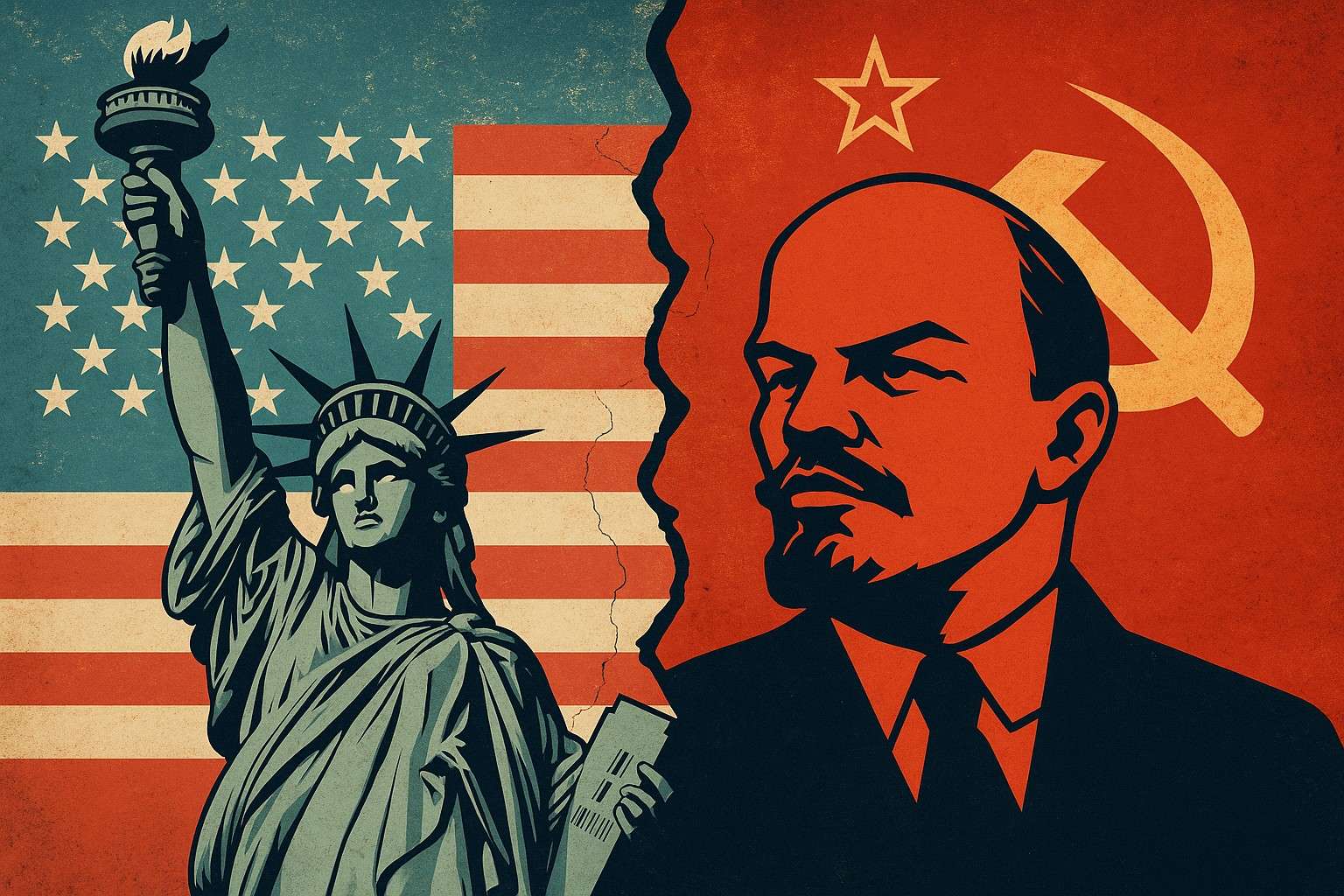The Cold War, lasting from roughly 1947 to 1991, was a prolonged period of political, ideological, and military tension between the United States and its allies, representing the capitalist West, and the Soviet Union and its allies, representing the communist East. Unlike traditional wars, the Cold War was marked not by direct large-scale fighting between the two superpowers, but by proxy wars, espionage, political subversion, and a fierce competition for global influence. At the heart of this conflict lay a fundamental ideological divide: capitalism versus communism. These conflicting visions of political and economic organization shaped international relations, domestic policies, and cultural life across the globe for nearly half a century.
The origins of the Cold War can be traced back to the aftermath of World War II. The wartime alliance between the United States, the United Kingdom, and the Soviet Union was one of convenience rather than shared values. Once the common enemy Nazi Germany was defeated, underlying tensions between the capitalist democracies and the communist regime of Joseph Stalin quickly resurfaced. The Yalta and Potsdam Conferences of 1945 revealed deep disagreements over the future of Eastern Europe. While Western powers advocated for free elections and self-determination, Stalin sought to establish a buffer zone of friendly, communist-leaning governments to protect the Soviet Union from potential future invasions. The division of Germany, and particularly the city of Berlin, soon became symbolic of the broader ideological rift.
In response to what it saw as Soviet expansionism, the United States adopted a policy of containment, articulated by diplomat George F. Kennan. The Truman Doctrine of 1947 formalized this stance, promising American support to countries threatened by communism. This was quickly followed by the Marshall Plan, a massive economic aid program aimed at rebuilding war-torn Western Europe and preventing the spread of communism through economic instability. The Soviet Union, viewing these moves as attempts to undermine its influence, responded by tightening control over Eastern Bloc countries and establishing the Cominform to coordinate communist activities.
The Cold War soon manifested itself in a series of proxy wars, where the superpowers supported opposing sides in regional conflicts. One of the earliest and most notable was the Korean War (1950–1953), where North Korea, backed by China and the Soviet Union, invaded South Korea, which was supported by the United States and United Nations forces. The war ended in a stalemate but set a precedent for Cold War military interventions. Similar patterns emerged in Vietnam, where the U.S. sought to prevent the spread of communism in Southeast Asia, and in Afghanistan, where the Soviet Union attempted to prop up a communist government in the face of a U.S.-backed insurgency.
Beyond military conflicts, the Cold War was characterized by a global arms race and a constant threat of nuclear annihilation. The successful development of nuclear weapons by the Soviet Union in 1949 ended the U.S. monopoly on atomic power and initiated a dangerous period of mutual suspicion. The Cuban Missile Crisis of 1962 brought the world to the brink of nuclear war, as the Soviet Union attempted to install nuclear missiles in Cuba, just 90 miles from the American coast. A tense 13-day standoff followed, ending only when the USSR agreed to withdraw its missiles in exchange for a U.S. promise not to invade Cuba and the secret removal of American missiles from Turkey. The crisis highlighted the dangers of brinkmanship and led to greater emphasis on arms control, including treaties such as the Nuclear Non-Proliferation Treaty (1968) and the Strategic Arms Limitation Talks (SALT) in the 1970s.
Ideological conflict was not limited to the battlefield or the missile silo. It permeated every aspect of life, from education and propaganda to space exploration and sports. The Soviet Union promoted communism as a more just and equitable alternative to Western capitalism, emphasizing state control over the economy, universal healthcare, and education. In contrast, the West championed democracy, individual freedoms, and market economies. These competing narratives were broadcast to the world through media, cultural exchanges, and international organizations. The Space Race became a particularly vivid illustration of Cold War competition, with the Soviet launch of Sputnik in 1957 and the U.S. moon landing in 1969 symbolizing technological prowess and ideological superiority.
At home, the Cold War had profound social and political consequences. In the United States, fears of communist infiltration led to the Red Scare, McCarthyism, and widespread violations of civil liberties. Loyalty oaths, blacklists, and government surveillance became common. In the Soviet Union and Eastern Bloc countries, dissent was often brutally suppressed, and state propaganda reinforced the image of the capitalist West as morally corrupt and militarily aggressive. The Berlin Wall, constructed in 1961, physically embodied the division between the two worlds—separating families and ideologies in one of the Cold War’s most potent symbols.
Despite the apparent permanence of the Cold War divide, the conflict began to thaw in the late 1980s. Several factors contributed to this shift. The Soviet economy was stagnating, and its political system was increasingly seen as inefficient and unresponsive. Reform-minded leader Mikhail Gorbachev introduced policies of glasnost (openness) and perestroika (restructuring), seeking to modernize the Soviet Union and reduce tensions with the West. At the same time, popular movements in Eastern Europe demanded greater freedom and autonomy. In 1989, a wave of revolutions swept through the Eastern Bloc, toppling communist regimes with little Soviet resistance. The fall of the Berlin Wall in November 1989 became the defining moment of this transformation.
The Cold War formally ended with the dissolution of the Soviet Union in 1991, marking a victory at least in ideological terms for liberal democracy and market capitalism. Yet, the legacy of the Cold War remains deeply embedded in global politics. Former Cold War alliances, such as NATO and the remnants of the Warsaw Pact, continue to influence international relations. Many regional conflicts and geopolitical rivalries have roots in Cold War-era interventions and alignments. Moreover, the ideological contest between authoritarianism and democracy has resurfaced in new forms in the 21st century.
In conclusion, the Cold War was more than just a geopolitical standoff; it was a global struggle between competing ideologies that shaped the political, economic, and cultural contours of the modern world. Its influence extended far beyond the borders of the United States and the Soviet Union, affecting virtually every region on the planet. While the Cold War may have ended in a formal sense, the ideological debates it sparked continue to resonate in today’s complex international landscape.
– Dr. Priyanka Singh, Humanities and Social Science
History, Madhav University

